Related Research Articles

Chaparral is a shrubland plant community found primarily in California, in southern Oregon and in the northern portion of the Baja California Peninsula in Mexico. It is shaped by a Mediterranean climate and infrequent, high-intensity crown fires.
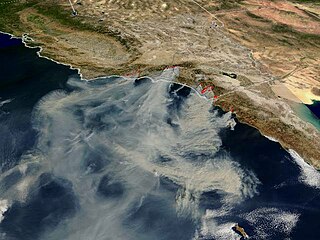
The Cedar Fire was a massive, highly-destructive wildfire, which burned 273,246 acres (1,106 km2) of land in San Diego County, California, during October and November 2003. The fire's rapid growth was driven by the Santa Ana wind, causing the fire to spread at a rate of 3,600 acres (15 km2) per hour. By the time the fire was fully contained on November 4, it had destroyed 2,820 buildings and killed 15 people, including one firefighter. Hotspots continued to burn within the Cedar Fire's perimeter until December 5, 2003, when the fire was fully brought under control.
The Laguna Fire, also known as the Kitchen Creek Fire or the Boulder Oaks Fire, was a 175,425-acre (70,992 ha) wildfire that burned from September 22 to October 4, 1970, in the Laguna Mountains and East County region of San Diego County in Southern California. It was one of many wildfires in a massive conflagration that spanned across the state from September 22 to October 4, 1970. At the time, it was the second-largest fire in the recorded history of California after the 1932 Matilija Fire.
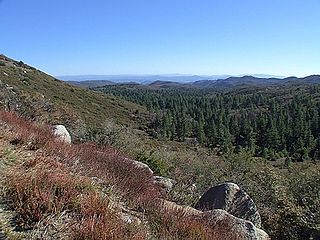
The Cleveland National Forest encompasses 460,000 acres/720 sq mi (1,900 km2) of inland montane regions—approx. 60 miles from the Pacific Ocean—within the counties of San Diego, Riverside, and Orange, California. The landscape varies somewhat, with mostly chaparral canyons, arroyos and high desert, but dotted with meadows and oak and conifer forests. Near water sources, riparian environments and perennial aquatic plants attract native and migratory wildlife, such as at San Diego’s man-made Lake Cuyamaca. A generally warm and dry, inland-Mediterranean climate prevails over the forest, with the cooler months producing morning frost and snowfall. It is the southernmost U.S. National Forest of California. The area is administered by the U.S. Forest Service, a government agency within the United States Department of Agriculture, and is locally overseen by the Descanso, Palomar and Trabuco Ranger Districts.

The Old Fire was a large complex wildfire that started on October 25, 2003, near Old Waterman Canyon Road and California State Route 18 in the San Bernardino Mountains, in San Bernardino County, Southern California, United States. The Old Fire caused at least $1.2 billion in damages.

The 2007 California wildfire season saw at least 9,093 separate wildfires that charred 1,520,362 acres (6,152.69 km2) of land. Thirty of those wildfires were part of the Fall 2007 California firestorm, which burned approximately 972,147 acres of land from Santa Barbara County to the U.S.–Mexico border. At the peak of the wildfire activity in October 2007, the raging wildfires were visible from space.

The Witch Creek Fire, also known as the Witch Fire, was the second-largest wildfire of the 2007 California wildfire season, burning 197,990 acres (801 km2) of land in San Diego County. Fanned by powerful Santa Ana winds, the Witch Creek Fire rapidly spread westward and consumed large portions of San Diego County. During its duration, flames reached 80 to 100 feet high, and the Witch Fire exhibited the characteristics of a firestorm at its height.

The Santiago Fire was a wildfire located near Santiago Canyon in Orange County, California, U.S., and one of thirty California wildfires of October 2007. The fire was intentionally started.
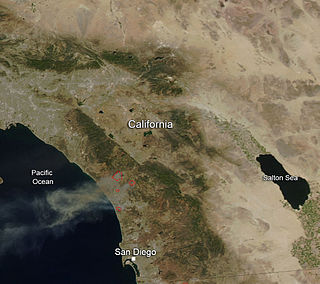
The May 2014 San Diego County wildfires were a swarm of 20 wildfires that erupted during May 2014, in San Diego County, California, during severe Santa Ana Wind conditions, historic drought conditions, and a heat wave. The main event during mid-May was preceded by a precursor fire that ignited on May 5. The Bernardo Fire has been declared accidental, and officials believe the Cocos Fire was intentionally set. The causes of the other fires are still under investigation by multiple agencies, and a joint task force was formed to coordinate the investigations and facilitate communications. Six injuries and one fire-related fatality were reported.

The October 2007 California wildfires, also known as the Fall 2007 California firestorm, were a series of about thirty wildfires that began igniting across Southern California on October 20. At least 1,500 homes were destroyed and approximately 972,147 acres of land was burned from Santa Barbara County to the U.S.–Mexico border, surpassing the October 2003 California wildfires in scope, which were estimated to have burned 800,000 acres (3,200 km2). The wildfires killed a total of 14 people, with nine of them dying directly from the fires; 160 others were injured, including at least 124 firefighters. At their height, the raging fires were visible from space. These fires included the vast majority of the largest and deadliest wildfires of the 2007 California wildfire season. The only wildfire in 2007 that surpassed any of the individual October 2007 fires in size was the Zaca Fire.

In terms of property damage, 2017 was the most destructive wildfire season on record in California at the time, surpassed by only the 2018 season and the 2020 season, with a total of 9,560 fires burning 1,548,429 acres (6,266.27 km2) of land, according to the California Department of Forestry and Fire Protection, including five of the 20 most destructive wildland-urban interface fires in the state's history. Throughout 2017, the fires destroyed or damaged more than 10,000 structures in the state, a higher tally than the previous nine years combined. State data showed that the large wildfires killed 47 people – 45 civilians and 2 firefighters – almost higher than the previous 10 years combined. The total property damage and total amount of burned land were both surpassed by the 2018 California wildfires.

The Creek Fire was a large wildfire that burned in Kagel Canyon and the Angeles National Forest north of Sylmar, a neighborhood in Los Angeles, California, United States, and one of multiple wildfires that broke out across Southern California in December 2017. The Creek Fire burned 15,619 acres (63 km2) and destroyed 123 structures, including 60 homes, before being contained on January 9, 2018, following heavy rainfall from a winter storm. The fire threatened the communities of Santa Clarita, Glendale, Olive View, Lake View Terrace, Sunland-Tujunga, Shadow Hills, Sylmar, Pacoima, Lopez Canyon, and Kagel Canyon, as well as the Olive View–UCLA Medical Center. During the wildfire, 115,000 residents were forced to evacuate their homes.
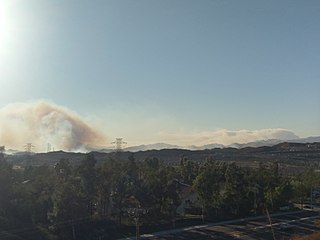
The Rye Fire was a wildfire that burned in Santa Clarita, California, in the United States, and one of multiple wildfires that broke out across Southern California in December 2017. The fire threatened over 5,000 structures, including Six Flags Magic Mountain, threatened the city of Santa Clarita and impacted traffic on Interstate 5. The Rye Fire burned a total of 6,049 acres (24.48 km2), before it was fully contained on December 12. The fire destroyed six buildings, including minor structures located at the Peter J. Pitchess Detention Center.

A series of 29 wildfires ignited across Southern California in December 2017. Six of the fires became significant wildfires, and led to widespread evacuations and property losses. The wildfires burned over 307,900 acres (1,246 km2), and caused traffic disruptions, school closures, hazardous air conditions, and power outages; over 230,000 people were forced to evacuate. The largest of the wildfires was the Thomas Fire, which grew to 281,893 acres (1,140.78 km2), and became the largest wildfire in modern California history, until it was surpassed by the Ranch Fire in the Mendocino Complex, in the following year.

The Lilac Fire was a fire that burned in northern San Diego County, California, United States, and the second-costliest one of multiple wildfires that erupted in Southern California in December 2017. The fire was first reported on December 7, 2017, burned 4,100 acres (1,659 ha), and destroyed 157 structures, before it was fully contained on December 16. The fire cost at least $8.9 million, including $5 million in firefighting expenses and property damage, and an additional $3.9 million in cleanup and erosion control costs. The fire threatened the communities of Bonsall, Oceanside, Vista, Fallbrook, and Camp Pendleton. During the fire, an estimated 10,000 residents were forced to evacuate, while a total of over 100,000 residents were forced to or advised to evacuate. On December 7, the Lilac Fire also cut the power to 20,000 people.
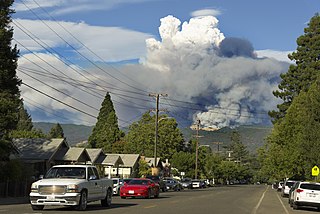
The Mendocino Complex Fire was a large complex of wildfires that burned in northern California for more than three months in 2018. It consisted of two wildfires, the River Fire and Ranch Fire, which burned in Mendocino, Lake, Colusa, and Glenn Counties in the U.S. State of California, with the Ranch Fire being California's single-largest recorded wildfire at the time until the Dixie Fire in 2021. The Ranch Fire burned eight miles northeast of Ukiah, and the River Fire burned six miles north of Hopland, to the south of the larger Ranch Fire. First reported on July 27, 2018, both fires burned a combined total of 459,123 acres (1,858 km2), before they were collectively 100% contained on September 18, though hotspots persisted until the complex was fully brought under control on January 4, 2019. The Ranch Fire alone burned 410,203 acres (1,660 km2), making it the largest wildfire in modern California history at the time until the August Complex fire that occurred in 2020. The Ranch Fire also surpassed the size of the 315,577-acre Rush Fire, which burned across California and Nevada, as well as the Santiago Canyon Fire of 1889, which was previously believed to have been California's all-time largest wildfire.
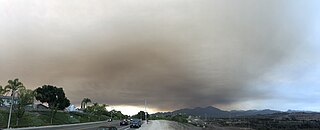
The Holy Fire was a wildfire that burned in the Cleveland National Forest in Orange and Riverside Counties, California. The wildfire started on August 6, 2018 at around 1:15 PM PDT, in the vicinity of Trabuco Canyon. A suspected arsonist was booked into the Orange County jail in Santa Ana, California but found not guilty in 2023. The blaze burned 23,136 acres (94 km2) and destroyed 18 buildings, before it was fully contained on September 13, 2018. While the fire was actively spreading in early and mid-August, residents of the nearby cities of Corona, Temescal Valley, and Lake Elsinore were placed under evacuation orders.
The Matilija Fire was a major wildfire that burned nearly 220,000 acres (89,000 ha) in the Santa Barbara National Forest of Southern California, during the autumn of 1932. The fire is named for Matilija Creek, near the location from which it originated.
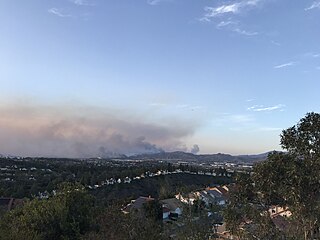
The Silverado Fire was a wildfire that burned in October and November 2020 in southern Orange County, California northeast of Irvine. The fire started on October 26 around 6:47 AM near Orange County Route S-18 and Silverado Canyon Road, fueled by strong Santa Ana winds gusting up to 80 miles per hour (130 km/h) and low humidity. Orange County Fire Authority Chief Brian Fennessy stated, "The winds were extraordinary even by Santa Ana standards. Fire spread is exceeding more than anything I've seen in my 44 years." The fire initially moved south from Loma Ridge toward the Orchard Hills, Northwood and Portola Springs communities of Irvine before moving southeast through Limestone Canyon and toward the communities of Foothill Ranch and Lake Forest. The fire burned in a path similar to that taken by the 2007 Santiago Fire, mostly through terrain that had not seen significant burning in the 13 years since that fire. 100% containment was announced on November 7, 2020.

The Kinneloa Fire was a destructive wildfire in October 1993 in Los Angeles County, California. The fire burned 196 structures in the San Gabriel Mountains foothill communities of Altadena, Kinneloa Mesa, and Sierra Madre, becoming the 12th most destructive wildfire in recorded California history at the time and to this day one of the most destructive wildfires in Los Angeles County history. The fire resulted in one fatality and a multitude of minor injuries: one person died of pneumonia complicated by smoke inhalation, and two indirect deaths resulted from debris flows in the burn area more than four months later.
References
Citations
- 1 2 3 4 5 6 Keeley, J.E; Zedler, P.H. (2009). "Large, high-intensity fire events in southern California shrublands: debunking the fine-grain age-patch mosaic model" (PDF). Ecological Applications. 19 (1): 69–94. doi:10.1890/08-0281.1. PMID 19323174. S2CID 18357602. Archived (PDF) from the original on 2009-09-20. Retrieved 2009-02-02.
- 1 2 3 Goforth, B.R.; Minnich, R.A. (2007). "Evidence, exaggeration, and error in historical accounts of chaparral wildfires in California" (PDF). Ecological Applications. 17 (3): 779–790. doi:10.1890/06-0831. PMID 17494396. Archived from the original on 2007-09-28.
{{cite journal}}: CS1 maint: bot: original URL status unknown (link) - 1 2 Brittny Mejia (December 15, 2017). "Thomas fire could surpass 1889 Santiago Canyon fire, believed to be California's largest". Los Angeles Times . Archived from the original on December 16, 2017. Retrieved December 15, 2017.
- 1 2 Brigandi, Phil. "The Biggest Fire You've (N)ever Heard Of". OC Historyland. Archived from the original on November 4, 2020. Retrieved January 13, 2021.
- ↑ Chris Wilson; David Johnson; Jennifer Calfas (16 August 2018). "California's Massive Wildfires Are Nearly 10 Times the Size of San Francisco". Time. Archived from the original on August 17, 2018. Retrieved 18 August 2018.
- ↑ Chane Croucher (7 August 2018). "400, Firefighters Battle Mendocino Complex Fire, The Largest Blaze In California History". Newsweek. Archived from the original on 18 August 2018. Retrieved 18 August 2018.
- 1 2 Daily San Diegan. 1889-09-30.
{{cite news}}: Missing or empty|title=(help) - ↑ Halsey, R.W. (2008). Fire, Chaparral, and Survival in Southern California. San Diego. CA: Sunbelt Publications. ISBN 978-0932653697.
- ↑ Orange News. 1889-09-02.
{{cite news}}: Missing or empty|title=(help) - ↑ Riverside Daily Press and Tribune. 1889-09-25.
{{cite news}}: Missing or empty|title=(help) - ↑ Daily Courier. San Bernardino. 1889-09-27.
{{cite news}}: Missing or empty|title=(help)
Bibliography
- Keeley, J.E.; Pastor, Elsa; z?Rate, Luis; Planas, Eul?lia; Arnaldos, Josep (2004). "Impact of Antecedent Climate on Fire Regimes in Coastal California" (PDF). International Journal of Wildland Fire. 13: 1–11. doi:10.1071/WF03001. Archived from the original on 2004-10-19.
{{cite journal}}: CS1 maint: bot: original URL status unknown (link) - Keeley, J.E.; Fotheringham, C.J.; Moritz, M.A. (2004). "Lessons from the 2003 wildfires in southern California" (PDF). Journal of Forestry. 102: 26–31. Archived from the original on 2006-05-28.
{{cite journal}}: CS1 maint: bot: original URL status unknown (link)